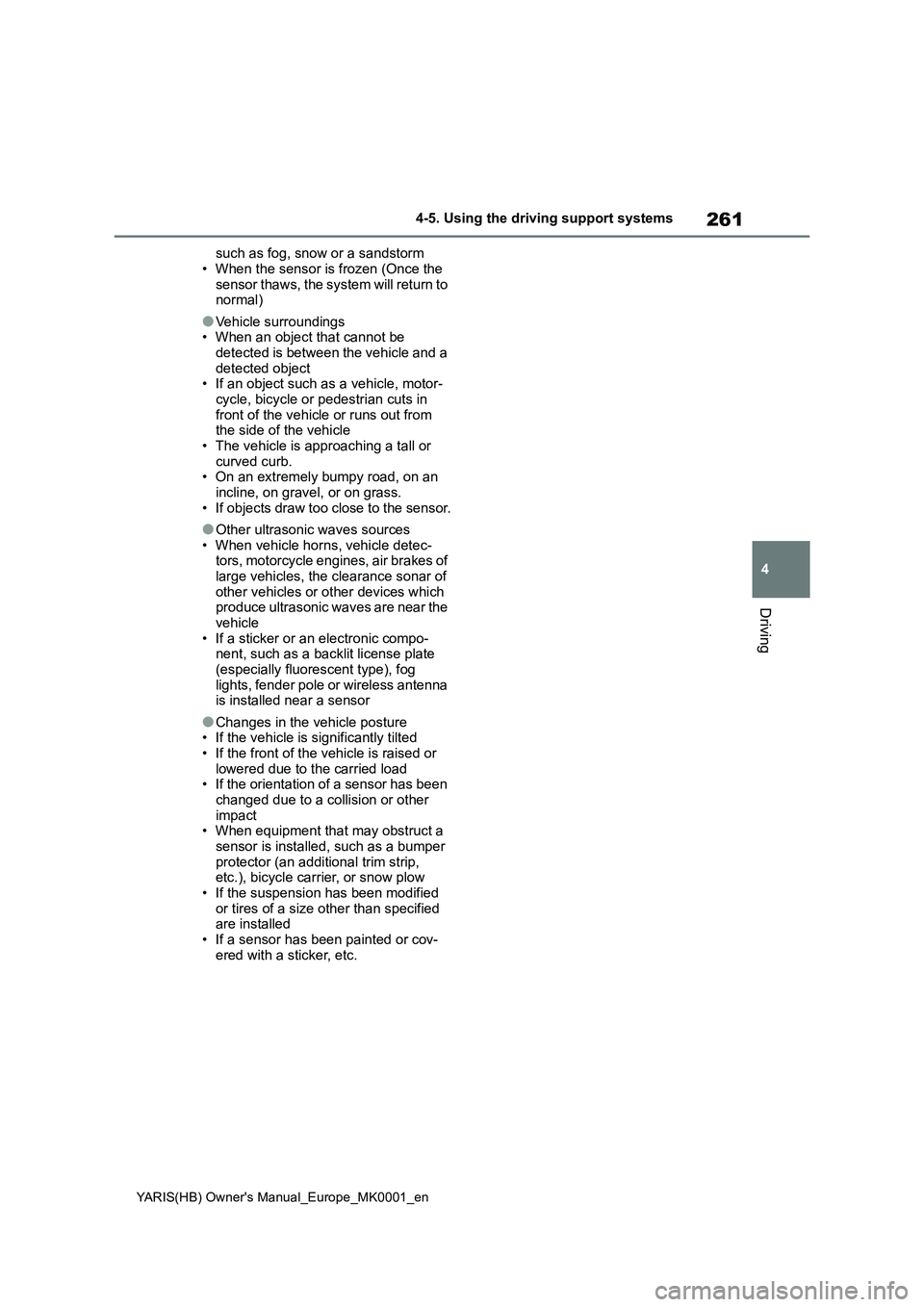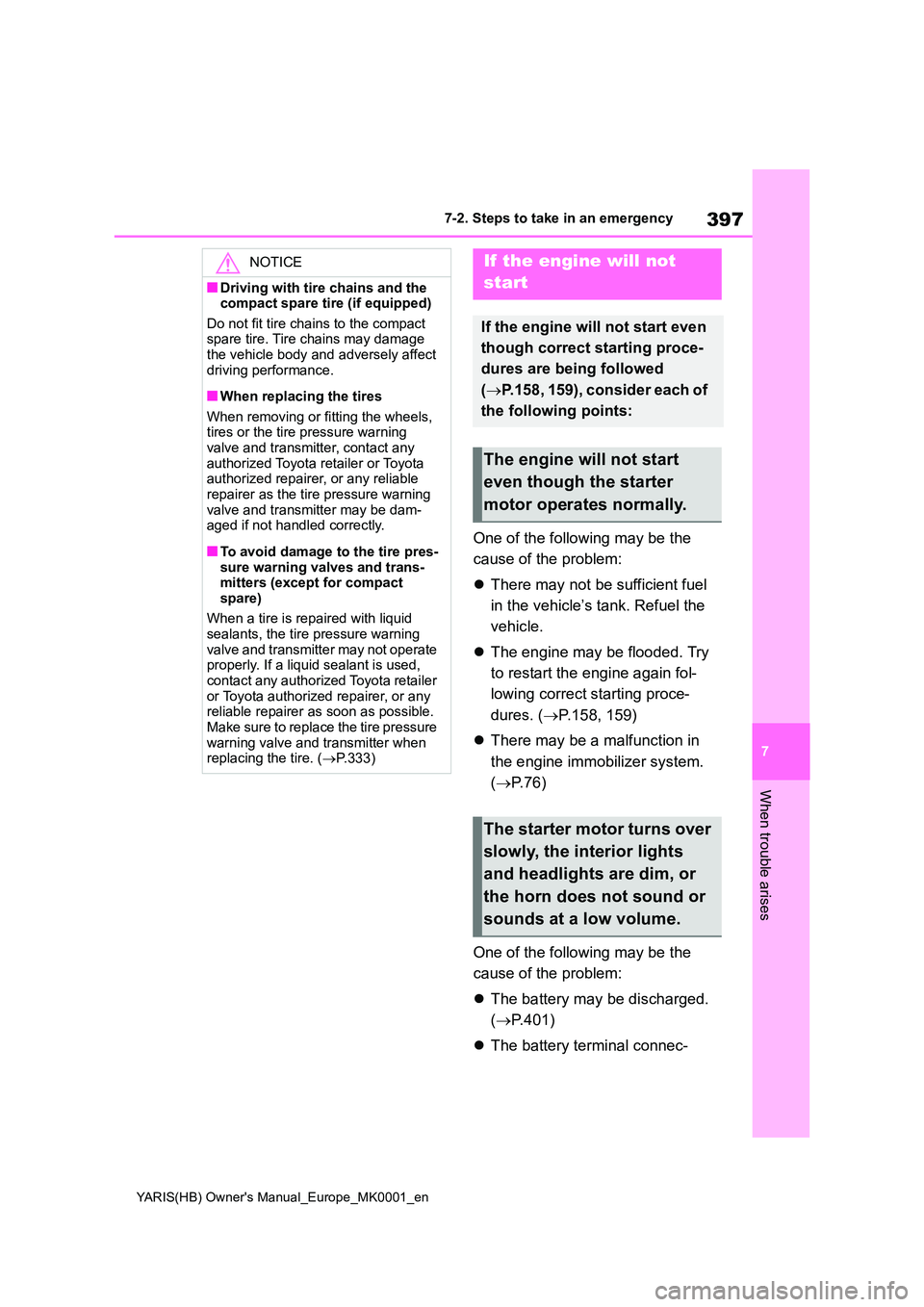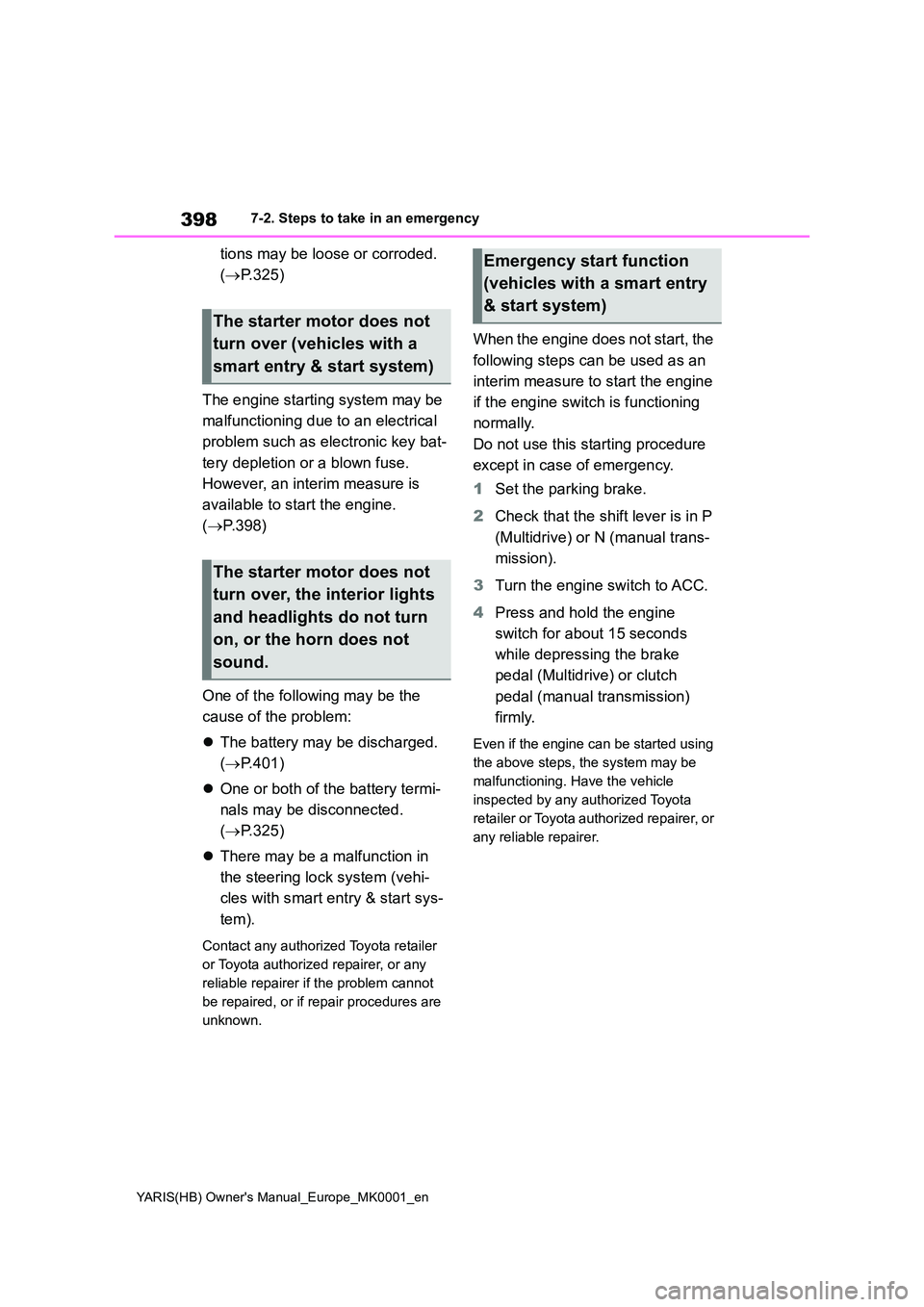2021 TOYOTA YARIS horn
[x] Cancel search: hornPage 134 of 568

134
YARIS(HB) Owner's Manual_Europe_MK0001_en
3-4. Adjusting the steering wheel and mirrors
3-4.Adjusting the steering whe el an d mirrors
1Hold the steering wheel and
push the lever down.
2 Adjust to the ideal position by
moving the steering wheel hori-
zontally and vertically.
After adjustment, pull the lever up to
secure the steering wheel.
To sound the horn, press on or
close to the mark.
Steering wheel
Adjustment procedure
WARNING
■Caution while driving
Do not adjust the steering wheel while driving.Doing so may cause the driver to mis-
handle the vehicle and cause an acci- dent, resulting in death or serious injury.
■After adjusting the steering wheel
Make sure that the steering wheel is
securely locked. Otherwise, the steering wheel may move suddenly, possibly causing an
accident, and resulting in death or serious injury. Also, the horn may not sound if the steering wheel is not
securely locked.
Horn
Page 245 of 568

245
4
YARIS(HB) Owner's Manual_Europe_MK0001_en
4-5. Using the driving support systems
Driving
●There will be a short delay between
object detection and display. Even at low speeds, there is a possibility that the object will come within the sen-
sor’s detection areas before the dis- play is shown and the warning beep sounds.
●It might be difficult to hear the buzzer due to the volume of the audio system
or air flow noise of the air conditioning system.
●It may be difficult to hear the buzzer if buzzers for other systems are sound-ing.
■Conditions under which the func-
tion may not function correctly
Certain vehicle conditions and the sur- rounding environment may affect the
ability of a sensor to correctly detect objects. Particular instances where this may occur are listed below.
●There is dirt, snow, water drops or ice on a sensor. (Cleaning the sensors
will resolve this problem.)
●A sensor is frozen. (Thawing the area
will resolve this problem.) In especially cold weather, if a sensor is frozen the sensor display may be
displayed abnormally, or objects, such as a wall, may not be detected.
●A sensor is covered in any way.
●When a sensor or the area around a
sensor is extremely hot or cold.
●On an extremely bumpy road, on an
incline, on gravel, or on grass.
●The vicinity of the vehicle is noisy due
to vehicle horns, motorcycle engines, air brakes of large vehicles, or other loud noises producing ultrasonic
waves.
●There is another vehicle equipped
with parking assist sensors in the vicinity.
●A sensor is coated with a sheet of spray or heavy rain.
●If a sensor is hit by a large amount of water, such as when driving on a
flooded road.
●If the vehicle is significantly tilted.
●The vehicle is approaching a tall or curved curb.
●If objects draw too close to the sensor.
■Objects which may not be properly detected
The shape of the object may prevent the
sensor from detecting it. Pay particular attention to the following objects:
●Wires, fences, ropes, etc.
●Cotton, snow and other materials that
absorb sound waves
●Sharply-angled objects
●Low objects
●Tall objects with upper sections pro- jecting outwards in the direction of your vehicle
People may not be detected if they are wearing certain types of clothing.
■Detection range of the sensors
Approximately 100 cm (3.3 ft.)
Approximately 150 cm (4.9 ft.)
Sensor detection display,
object distance
Page 260 of 568

260
YARIS(HB) Owner's Manual_Europe_MK0001_en
4-5. Using the driving support systems
●Vehicle surroundings
• When driving on a narrow road
• When driving on a gravel road or in an
area with tall grass
• When driving toward a banner, flag,
low-hanging branch or boom barrier (such as those used at railroad cross-ings, toll gates and parking lots)
• When driving on a narrow path sur- rounded by a structure, such as in a tunnel or on an iron bridge
• When parallel parking • When there is a rut or hole in the sur-face of the road
• When driving on a metal cover (grat- ing), such as those used for drainage ditches
• When driving on a steep slope • If a sensor is hit by a large amount of water, such as when driving on a
flooded road
●Weather
• If a sensor is covered with ice, snow, dirt, etc. (when cleared, the system will return to normal)
• If heavy rain or water strikes a sensor • When driving in inclement weather such as fog, snow or a sandstorm
• When strong winds are blowing
●Other ultrasonic wave sources
• When vehicle horns, vehicle detec- tors, motorcycle engines, air brakes of large vehicles, the clearance sonar of
other vehicles or other devices which
produce ultrasonic waves are near the vehicle• If a sticker or an electronic compo-
nent, such as a backlit license plate (especially fluorescent type), fog lights, fender pole or wireless antenna
is installed near a sensor
●Changes in the vehicle posture
• If the vehicle is significantly tilted • If the front of the vehicle is raised or lowered due to the carried load
• If the orientation of a sensor has been changed due to a collision or other impact
• If a sensor has been painted or cov- ered with a sticker, etc.
■Situations in which the Parking Support Brake function (static
objects) may not operate properly
In some situations, such as the follow- ing, this function may not operate prop-
erly.
●Weather
• When a sensor or the area around a sensor is extremely hot or cold
• When strong winds are blowing
• If a sensor is covered with ice, snow,
dirt, etc. (when cleared, the system will return to normal)• If heavy rain or water strikes a sensor
• When driving in inclement weather
Page 261 of 568

261
4
YARIS(HB) Owner's Manual_Europe_MK0001_en
4-5. Using the driving support systems
Driving
such as fog, snow or a sandstorm
• When the sensor is frozen (Once the
sensor thaws, the system will return to
normal)
●Vehicle surroundings
• When an object that cannot be
detected is between the vehicle and a
detected object
• If an object such as a vehicle, motor-
cycle, bicycle or pedestrian cuts in
front of the vehicle or runs out from
the side of the vehicle
• The vehicle is approaching a tall or
curved curb.
• On an extremely bumpy road, on an
incline, on gravel, or on grass.
• If objects draw too close to the sensor.
●Other ultrasonic waves sources
• When vehicle horns, vehicle detec-
tors, motorcycle engines, air brakes of
large vehicles, the clearance sonar of
other vehicles or other devices which
produce ultrasonic waves are near the
vehicle
• If a sticker or an electronic compo-
nent, such as a backlit license plate
(especially fluorescent type), fog
lights, fender pole or wireless antenna
is installed near a sensor
●Changes in the vehicle posture
• If the vehicle is significantly tilted
• If the front of the vehicle is raised or
lowered due to the carried load
• If the orientation of a sensor has been
changed due to a collision or other
impact
• When equipment that may obstruct a
sensor is installed, such as a bumper
protector (an additional trim strip,
etc.), bicycle carrier, or snow plow
• If the suspension has been modified
or tires of a size other than specified
are installed
• If a sensor has been painted or cov-
ered with a sticker, etc.
Page 397 of 568

397
7
YARIS(HB) Owner's Manual_Europe_MK0001_en
7-2. Steps to take in an emergency
When trouble arises
One of the following may be the
cause of the problem:
�z There may not be sufficient fuel
in the vehicle’s tank. Refuel the
vehicle.
�z The engine may be flooded. Try
to restart the engine again fol-
lowing correct starting proce-
dures. ( →P.158, 159)
�z There may be a malfunction in
the engine immobilizer system.
( →P. 7 6 )
One of the following may be the
cause of the problem:
�z The battery may be discharged.
( →P.401)
�z The battery terminal connec-
NOTICE
■Driving with tire chains and the compact spare tire (if equipped)
Do not fit tire chains to the compact spare tire. Tire chains may damage the vehicle body and adversely affect
driving performance.
■When replacing the tires
When removing or fitting the wheels, tires or the tire pressure warning valve and transmitter, contact any
authorized Toyota retailer or Toyota authorized repairer, or any reliable repairer as the tire pressure warning
valve and transmitter may be dam- aged if not handled correctly.
■To avoid damage to the tire pres-sure warning valves and trans-mitters (except for compact
spare)
When a tire is repaired with liquid sealants, the tire pressure warning
valve and transmitter may not operate properly. If a liquid sealant is used, contact any authorized Toyota retailer
or Toyota authorized repairer, or any reliable repairer as soon as possible. Make sure to replace the tire pressure
warning valve and transmitter when replacing the tire. ( →P.333)
If the engine will not
start
If the engine will not start even
though correct starting proce-
dures are being followed
( →P.158, 159), consider each of
the following points:
The engine will not start
even though the starter
motor operates normally.
The starter motor turns over
slowly, the interior lights
and headlights are dim, or
the horn does not sound or
sounds at a low volume.
Page 398 of 568

398
YARIS(HB) Owner's Manual_Europe_MK0001_en
7-2. Steps to take in an emergency
tions may be loose or corroded.
( →P.325)
The engine starting system may be
malfunctioning due to an electrical
problem such as electronic key bat-
tery depletion or a blown fuse.
However, an interim measure is
available to start the engine.
( →P.398)
One of the following may be the
cause of the problem:
�z The battery may be discharged.
( →P.401)
�z One or both of the battery termi-
nals may be disconnected.
( →P.325)
�z There may be a malfunction in
the steering lock system (vehi-
cles with smart entry & start sys-
tem).
Contact any authorized Toyota retailer
or Toyota authorized repairer, or any
reliable repairer if the problem cannot
be repaired, or if repair procedures are
unknown.
When the engine does not start, the
following steps can be used as an
interim measure to start the engine
if the engine switch is functioning
normally.
Do not use this starting procedure
except in case of emergency.
1 Set the parking brake.
2 Check that the shift lever is in P
(Multidrive) or N (manual trans-
mission).
3 Turn the engine switch to ACC.
4 Press and hold the engine
switch for about 15 seconds
while depressing the brake
pedal (Multidrive) or clutch
pedal (manual transmission)
firmly.
Even if the engine can be started using
the above steps, the system may be
malfunctioning. Have the vehicle
inspected by any authorized Toyota
retailer or Toyota authorized repairer, or
any reliable repairer.
The starter motor does not
turn over (vehicles with a
smart entry & start system)
The starter motor does not
turn over, the interior lights
and headlights do not turn
on, or the horn does not
sound.
Emergency start function
(vehicles with a smart entry
& start system)
Page 554 of 568

554
YARIS(HB) Owner's Manual_Europe_MK0001_en
What to do if... (Troubleshooting)
Is the parking brake released?
(→
P. 1 7 1)
Depending on the situation, other
types of warning buzzer may also
sound. (→P.368, 377)
�zDid anyone inside the vehicle
open a door during setting the
alarm?
The sensor detects it and the alarm
sounds. (→
P. 7 8)
Do one of the following to deacti-
vate or stop the alarms:
�zUnlock the doors using the entry
function (if equipped) or wireless
remote control.
�zStarting the engine. (The alarm
will be deactivated or stopped
after a few seconds.)
�zIs the electronic key left inside
the vehicle?
Check the message on the multi-infor-
mation display. (→
P.377)
�zWhen a warning light turns on or
a warning message is displayed,
refer to P.368, 377.�zVehicles with an emergency tire
puncture repair kit: Stop the vehi-
cle in a safe place and repair the
flat tire temporarily with the
emergency tire puncture repair
kit. (→P.379)
�zVehicles with spare tire: Stop the
vehicle in a safe place and
replace the flat tire with the spare
tire. (→P.389)
�zTry the procedure for when the
vehicle becomes stuck in mud,
dirt, or snow. (→P.408)
An alarm is activated and the
horn sounds (vehicles with
an alarm)
A warning buzzer sounds
when leaving the vehicle
(vehicles with a smart entry
& start system)
A warning light turns on or a
warning message is dis-
played
When a problem has
occurred
If you have a flat tire
The vehicle becomes stuck
Page 559 of 568

559
YARIS(HB) Owner's Manual_Europe_MK0001_en
Alphabetical Index
Headlamp temporary lighting func-
tion............................................... 175
Headlights
Automatic High Beam system .... 177
Headlamp temporary lighting func-
tion ........................................... 175
Light switch ................................ 173
Replacing light bulbs .......... 351, 352
Wattage ...................................... 419
Heated steering wheel ................. 289
Heaters
Automatic air conditioning system
................................................. 283
Heated steering wheel ............... 289
Heater system ............................ 278
Manual air conditioning system.. 278
Outside rear view mirrors ... 280, 285
Seat heaters............................... 289
High mounted stoplight
Replacing light bulbs .................. 352
Hill-start assist control................. 269
Hood .............................................. 317
Open .......................................... 317
Hooks
Coat hooks ................................. 304
Grocery bag hooks..................... 295
Retaining hooks (floor mat) .......... 30
Horn ............................................... 134
I
Identification
Engine ........................................ 411
Vehicle ....................................... 411
Ignition switch (engine switch) . 158,
159
Auto power off function .............. 162
Changing the engine switch modes
......................................... 158, 162
If your vehicle has to be stopped in
an emergency .......................... 360
Illuminated entry system ............. 292Indicators......................................... 84
Initialization
Engine oil maintenance data ...... 323
Items to initialize......................... 431
Parking Support Brake ............... 255
Power windows .......................... 139
Tire pressure warning system .... 334
Inside rear view mirror ................. 135
Intercooler ..................................... 324
Intercooler coolant .......................324
Capacity ..................................... 415
Checking .................................... 324
Interior lights ................................. 291
Front interior light .......................291
Rear interior light ........................ 291
Wattage ...................................... 419
J
Jack
Positioning a floor jack ............... 319
Vehicle-equipped jack ................ 390
Jack handle ...................................390
Jam protection function
Power windows .......................... 139
K
Keyless entry
Smart entry & start system ......... 123
Wireless remote control ............. 114
Keys ............................................... 112
Battery-saving function............... 124
Electronic key ............................. 112
Engine switch .....................158, 159
If the electronic key does not operate
properly .................................... 399
If you lose your keys ..................399
Key number plate ....................... 112
Keyless entry.............. 116, 121, 123
Mechanical key .......................... 112
Replacing the battery ................. 345